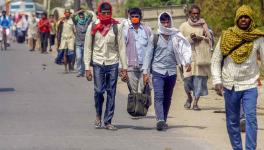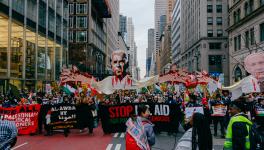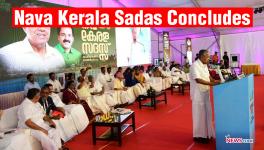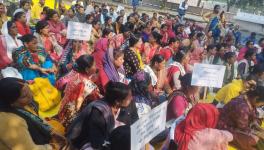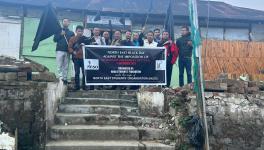‘There is No Alternative to Decentralised Covid Response’—Dr. K Srinath Reddy
Representational use only. Image Courtesy: Business Today
Prof. K Srinath Reddy, president of the Public Health Foundation of India, says India imposed a long nationwide lockdown while the COVID-19 case count was still small. Then the country unlocked in stages. By the time the second wave rushed in, India was a fully-open society, with few restrictions. Plus, the virus had mutated, and some mutations could be more virulent. These factors explain why the burden of the pandemic is so high in the second wave. Excerpts from an interview with Rashme Sehgal.
The second wave seems to be of tsunamic proportions. Experts are claiming, based on modelling studies, that COVID-19 cases are likely to go up to over one lakh a day by the first week of May in the populous states of West Bengal, Bihar, Uttar Pradesh and Chattisgarh. Maharashtra and Delhi are already reeling under the pressure of this wave. Can our medical facilities cope with this?
Modelling studies mostly assume a trajectory based on the current predominantly urban rates and do not adjust for lower rural transmission rates. Also, they do not take into account the potential effects of transmission containment measures which are likely to be instituted now. However, the threat of rapidly rising rates remains real and is alarming. Our medical facilities are severely stretched and are at the risk of collapsing in several places. We need to work very hard to check the rate of rising infections as fast as we can. We have to see how milder cases can be managed at home so that severe cases can get priority for hospitalisation.
A leading epidemiologist, also with the Public Health Foundation of India, has said that in these states each infected individual is spreading the disease to three others. Therefore, the second wave needs to be handled differently from the first. Is this the case, and if so, how?
We experienced the first wave when we imposed a long nationwide lockdown while the case count was still small. We then unlocked in stages, implementing several containment measures for several months. We started the second wave in a fully open society, with people moving and mingling at a faster pace. That would have given even the usual virus greater opportunity to spread but we now also have variants that are even more infectious. So, the rate and spread of transmission are greater in the fresh wave.
To cope with these figures, we will need to have 1,000 beds added to our hospitals every day. Will our medical infrastructure be able to provide so many beds?
Our hospital resources are getting severely strained, not just in terms of beds but also in terms of doctors and nurses who are working beyond the limits of human endurance and exhaustion. We can build makeshift hospitals to expand bed capacity but where will we get the staff? We have to treat the less severely affected patients at home so that serious patients can be admitted to hospitals.
Each state will need to tackle the virus spread differently. Is that possible given the government’s tendency to over centralise all decision making?
There is no workable alternative to decentralisation of the response, even to the district level. Support and inter-state coordination can be offered by the central government, planning and resource allocation can be done at the state capital level. But data-driven decentralised decision making has to be made at the district level. The ground reality and evolving situation are best assessed by the district leadership and local partnerships too can be built by them for concerted action.
Scientists are saying that the second wave in India is more virulent and more worrying than anywhere in the world; that there are now 5,000 variants of the Novel Coronavirus, and so on. Do you think this is the case?
It is difficult to say if the second wave is more virulent as case fatality rates are affected by many factors which differ between the first and the second waves. Even if the virus variants are not more virulent in terms of death rates, the absolute number of deaths will rise as the number of daily cases rises. We have to contain the transmission as fast as possible to limit the damage.
Delhi, for example, has a positivity rate of 13%. Does this mean that at any given time, 15 to 20 lakh people are infected by the virus?
The positivity rate is among people who are tested [for the virus]. They are tested either because they are symptomatic or [came in] contact with someone who had symptoms. Patients being screened for hospital admission for other conditions are also screened. These groups are not representative of the whole general population. Test positivity rates in such a select group cannot be extrapolated to estimate the numbers in the overall population of Delhi.
The case fatality has also risen. Earlier it was 1.1% and now it is 1.5%. People are being warned that this will only increase by early May. Does this sound correct?
The case fatality rate (CFR) has a numerator (deaths) and denominator (test positive cases). There is usually a 14-20 day lag between test diagnosis and death. However, when you do many tests, you may detect more mildly affected or asymptomatic persons, while restricted testing will usually be confined to the more sick patients. Deaths do not occur in asymptomatic and mildly symptomatic cases. So, large-scale testing tends to lower the CFR estimate by increasing the denominator much more than the numerator. We need to adjust for these variations when we assess CFR. We do need to track CFR keeping in mind the time lag between diagnosis and death.
Why has the government failed to provide us with Covid appropriate governance? Epidemiologists say all these surges are linked to large crowds, be it state or panchayat elections, or events like the Kumbh Mela.
That is a question that needs to be addressed to governments across the country. Perhaps, such events were planned on the incorrect premise that the pandemic had ended for India and would not return. Confident proclamations hailing the arrival of herd immunity did not help.
The Ministry of Health had a window of opportunity between January and March where they could have pushed for vaccination for all age groups. Do you agree?
Vaccines prevent severe disease. They do not immediately curtail transmission by blocking infection per se. In future, mucosal vaccines may do so, but the presently available systemic vaccines do not give an assurance of blocking infection. So, available vaccines must be prioritised for vaccinating essential workers and persons who are vulnerable to severe disease, if infected. The latter category includes persons whose higher age or associated health conditions put them at high risk.
In general, young persons do not get very sick even if infected. When vaccine supply is restricted, the essentiality of work and vulnerability to severe disease are the criteria applied in most countries. If we had an abundance of vaccines and plenty of vaccinating teams available immediately, we could have vaccinated all age groups straight away. That situation existed only for a handful of countries.
What is your response to the charge being levied by the European Union and medical groups in the United Kingdom that Covishield results in blood-clotting, thereby questioning its efficacy?
Regulators in the UK and European Union have reviewed the data and have concluded that blood clotting does occur as a very rare adverse event, as an autoimmune phenomenon associated with the AstraZeneca vaccine. Such adverse events have not been reported as yet in India with Covishield. It is the safety of the AstraZeneca vaccine that has raised concerns, not its efficacy.
While efficacy is the ability of a vaccine to protect against virus-induced severe disease and death, safety is the absence of serious adverse events caused by the vaccine. Efficacy measures protection against the virus. Safety measures protect from dangerous effects of the vaccine itself.
In the present conditions, how much time will it take for the government to vaccinate the entire population?
The situation is evolving. The Russian vaccine (Sputnik-V) has been given regulatory approval for both import and large-scale manufacture in India. Other internationally-approved vaccines, too, have been cleared for use in India. New vaccines are under trial in India. Both Covaxin and Covishield-makers have announced they will ramp up production capacity. It is only by July 2021 that we may have a better understanding of our evolving supply-chain, to make informed predictions about the anticipated timelines of vaccine coverage.
(Rashme Sehgal is a freelance journalist.)
Get the latest reports & analysis with people's perspective on Protests, movements & deep analytical videos, discussions of the current affairs in your Telegram app. Subscribe to NewsClick's Telegram channel & get Real-Time updates on stories, as they get published on our website.











